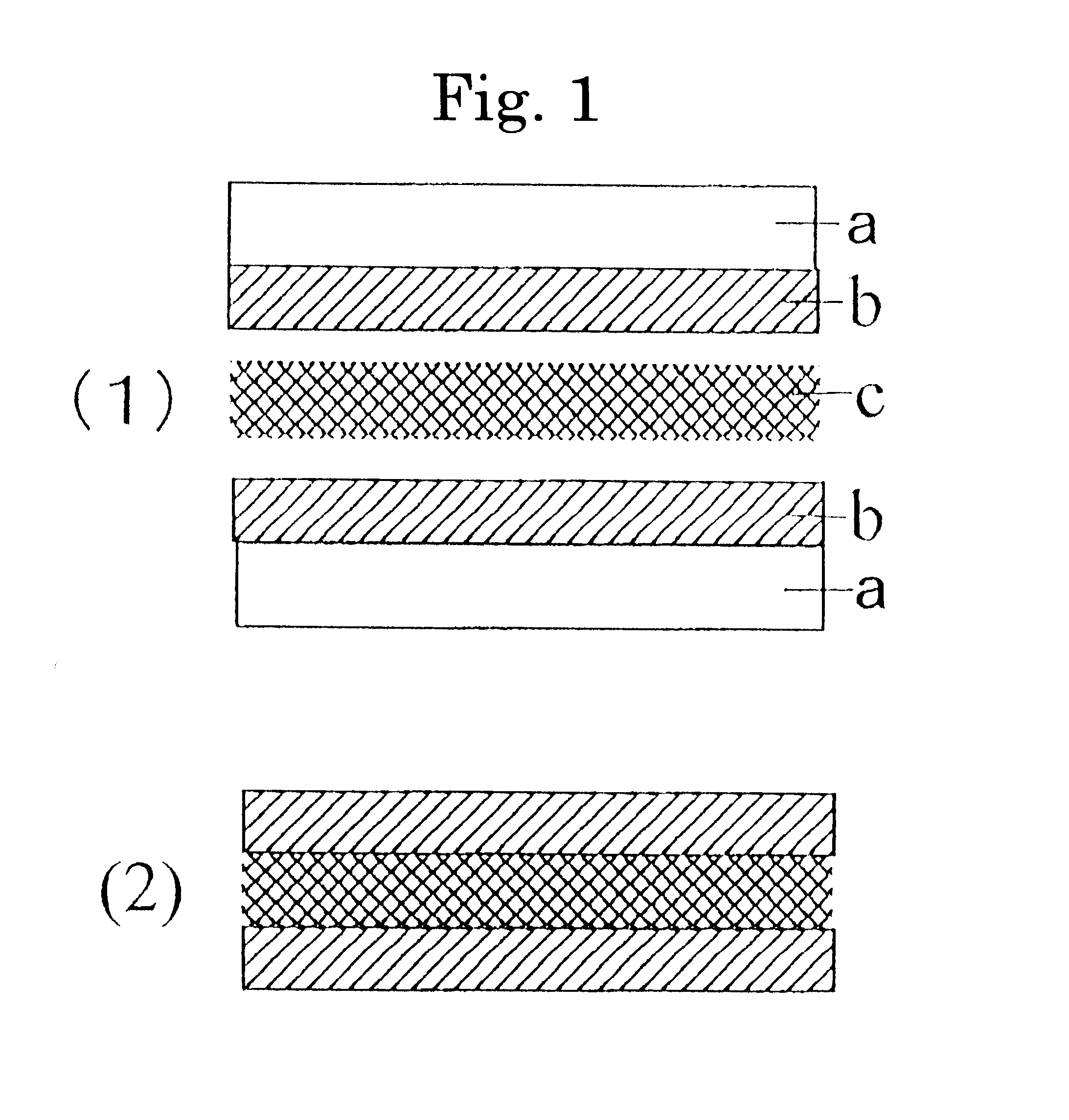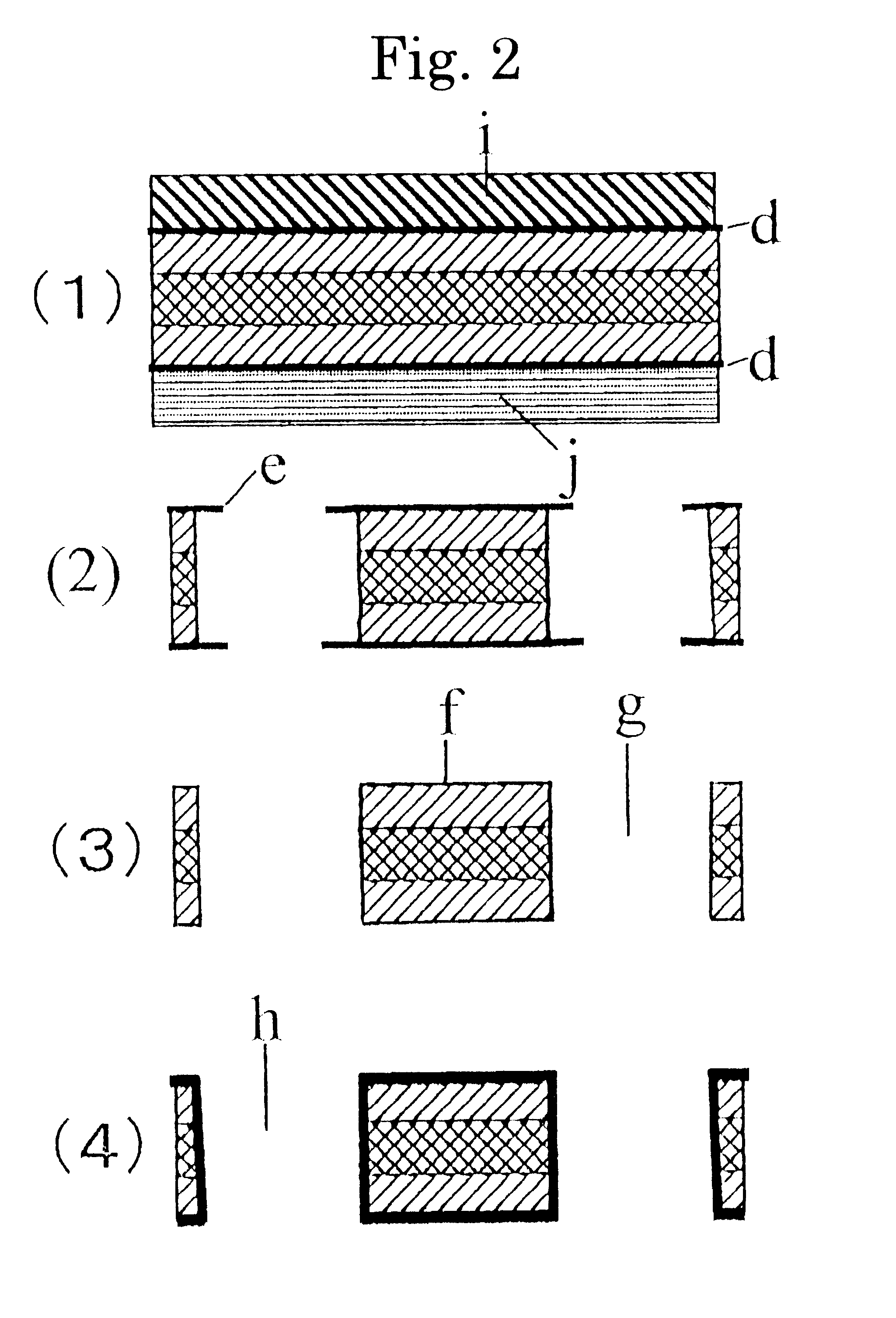High relative-permittivity B-staged sheet, high relative-permittivity prepreg, its production process, and printed wiring board comprising any one of these
a technology of relative permittivity and bstaged sheets, which is applied in the direction of light absorption dielectrics, adhesive processes with surface pretreatment, dielectric characteristics, etc., can solve the problems of difficult to impregnate glass fabric substrates with resin compositions, difficult to attach resin compositions in large amounts to the surface of fabrics, and difficult to produce glass fabric substrates with thinner insulation layers. , to achieve the effect of high relative permittivity, excellent heat resistance, and excellent adhesion
- Summary
- Abstract
- Description
- Claims
- Application Information
AI Technical Summary
Benefits of technology
Problems solved by technology
Method used
Image
Examples
examples 1 to 6
1,000 parts of 2,2-bis(4-cyanatophenyl)propane monomer (component A-1) was melted at 150.degree. C., and allowed to react with stirring for 4 hours, to give a prepolymer (component A-2) having an average molecular weight of 1,900. A bisphenol A type epoxy resin (trade name: Epikote 828, supplied by Yuka-Shell Epoxy K.K., component B-1), a bisphenol F type epoxy resin (trade name: EXA830LVP, supplied by Dainippon ink and chemicals, inc., component B-2) and / or a novolak type epoxy resin (trade name: DEN431, supplied by Dow Chemical, component B-3) as epoxy resins in a liquid state at room temperature were added. Iron acetylacetonate (component C-1) and 2-ethyl-4-methylimidazole (component C-2) as heat-curing catalysts and an epoxy silane coupling agent (trade name: A-187, supplied by Nihon Yunika K.K., component D-1) as an additive were added to the resultant mixture to obtain a varnish. As an inorganic filler, a barium titanate-containing ceramic (relative permittivity at 1 MHz at ro...
examples 7 to 14
1,000 parts of 2,2-bis(4-cyanatophenyl)propane monomer (component A-1) was melted at 150.degree. C., and allowed to react with stirring for 4 hours, to give a prepolymer (component A-2) having an average molecular weight of 1,900. A bisphenol A type epoxy resin (trade name: Epikote 828, supplied by Yuka-Shell Epoxy K.K., component B-1), a bisphenol F type epoxy resin (trade name: EXA830LVP, supplied by Dainippon ink and chemicals, inc., component B-2), a novolak type epoxy resin (trade name: DEN431, supplied by Dow Chemical, component B-3) and a cresol novolak type epoxy resin (trade name: ESCN-220F, supplied by Sumitomo Chemical Co., Ltd., component B-4), as epoxy resins in a liquid state at room temperature, iron acetylacetonate (component C-1) and / or 2-ethyl-4-methylimidazole (component C-2) as heat-curing catalysts and an epoxy silane coupling agent (trade name: A-187, supplied by Nihon Yunika K.K., component D-1) and dicyandiamide (component E-1) as additives in amounts shown i...
examples 15 to 19
The same components as those used in Examples 7 to 14 were mixed in amounts shown in Table 10. The mixture was uniformly kneaded with a mixer for 10 minutes. When the kneaded mixture had a high viscosity, methyl ethyl ketone in a small amount was added to the kneaded mixture to have a proper viscosity for application and to obtain a varnish. Symbols of the components have the same meanings as those in Examples 7 to 14. The varnish was continuously applied to one surface of a 50 .mu.m thick polyethylene terephthalate (PET) film to form a layer having a thickness of 40 .mu.m, and the layer was dried to obtain B-staged resin sheets having a resin flow of 1 to 20 mm at 170.degree. C. at 20 kgf / cm.sup.2 for five minutes.
A crystal polyester fiber having a fiber diameter of 13 .mu.m and a length of 16 mm was dispersed in a solution in which polyethylene oxide was dispersed, to prepare a non-woven fabric in which a mass per unit area of the fabric was 30 g / m.sup.2. 6% by weight, based on th...
PUM
| Property | Measurement | Unit |
|---|---|---|
| Fraction | aaaaa | aaaaa |
| Percent by mass | aaaaa | aaaaa |
| Percent by mass | aaaaa | aaaaa |
Abstract
Description
Claims
Application Information
 Login to View More
Login to View More - R&D
- Intellectual Property
- Life Sciences
- Materials
- Tech Scout
- Unparalleled Data Quality
- Higher Quality Content
- 60% Fewer Hallucinations
Browse by: Latest US Patents, China's latest patents, Technical Efficacy Thesaurus, Application Domain, Technology Topic, Popular Technical Reports.
© 2025 PatSnap. All rights reserved.Legal|Privacy policy|Modern Slavery Act Transparency Statement|Sitemap|About US| Contact US: help@patsnap.com


